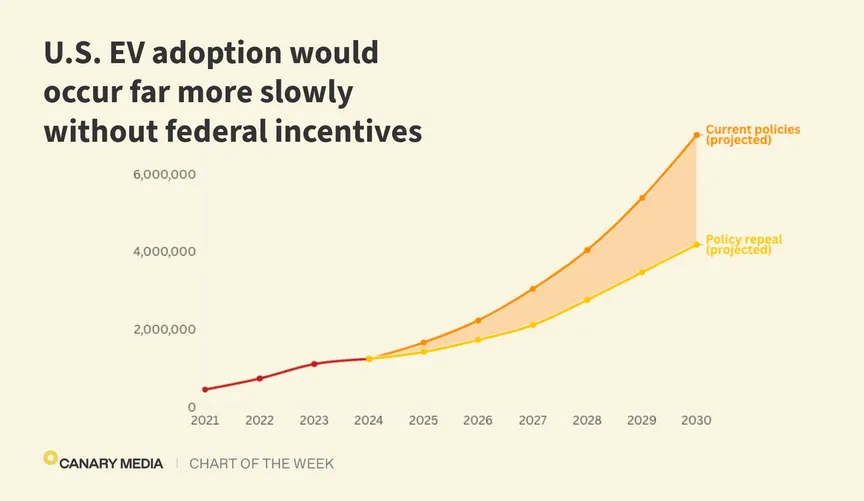
Republicans are looking to roll back key electric-vehicle incentives passed under the Biden administration. Doing so would kneecap the EV transition for years to come.
Under current policies, the number of light-duty EVs sold annually is forecast to climb to 7 million by 2030, according to a new analysis from the REPEAT Project at Princeton University. But if those policies — specifically the consumer EV tax credit and tailpipe emissions rules — are repealed, that figure is forecast to be 40% lower in 2030, at around 4.2 million.

Despite Detroit’s pleas, the Trump administration and congressional Republicans are seeking to eliminate the $7,500 EV tax credit as well as vehicle efficiency rules that incentivize automakers to stop making gas-fueled cars.
It would be a blow to a U.S. EV industry that’s already coming off a year of mixed success. On the one hand, consumers bought a record number of EVs in 2024 as models from automakers other than Tesla caught on. On the other hand, sales grew by just 7% compared with the year prior — a sluggish rate compared to the nearly 50% leap that occurred in 2023 — and automakers began walking back from their EV commitments even prior to President Donald Trump’s election.
Should Republicans succeed in repealing the tax credits and efficiency rules, it would further slow EV adoption — and in the process destroy jobs at EV and battery factories. The REPEAT Project analysis found that eliminating these policies would threaten plans to expand U.S. EV factories and potentially lead to the cancellation or closure of half of existing EV factory capacity. The moves would have a similar effect on the burgeoning battery belt.
More than 80% of announced investments in U.S. EV manufacturing are located in congressional districts represented by Republicans, according to a January report from the Environmental Defense Fund and WSP USA.
Beyond the economic ramifications of the potential repeal, the climate consequences are dire. Gas-powered vehicles are one of the largest sources of planet-warming carbon emissions in the U.S.; they also cause a significant amount of smog-forming pollution that can contribute to respiratory diseases like asthma. Slowing down the transition to electric vehicles would only serve to exacerbate these problems.
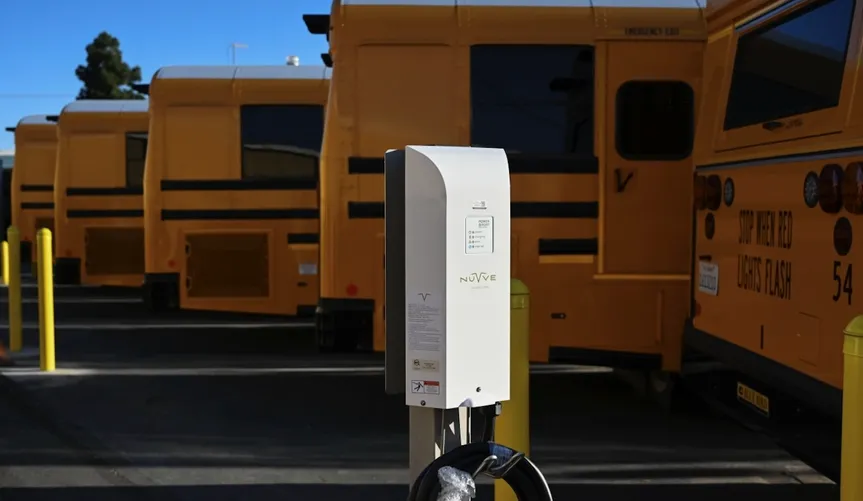
A handful of school buses in northern Illinois will soon have a new summer job.
ComEd is the latest utility to explore whether electric school buses could help manage the grid when school is out of session and air conditioners are humming.
Under such vehicle-to-grid, or V2G, arrangements, electric school buses charge up at night when power is cheap and plentiful, then discharge electricity to the grid when local power demand is high. This infusion can alleviate the need to fire up natural gas peaker plants, buy expensive power on the market, or even build new power plants.
The buses basically act as batteries attached to the grid, in a win-win situation where school districts are paid for the service and utilities get power that is cheaper and possibly cleaner than what they could otherwise acquire during peak hours.
V2G projects are still in nascent and pilot-project stages, and significant challenges exist. The grid needs to communicate seamlessly with the bus charging station, and operators must make sure bus batteries are ready when needed and that the grid isn’t overloaded by local bursts of energy. Standards and certifications for V2G technology and practice are also still in early stages.
“It takes a lot of effort to do those communications properly,” said Greggory Kresge, senior manager for utility engagement and transportation electrification at the World Resources Institute, a research and advocacy nonprofit focused on environmental and economic issues. “You have communication about speed, power level, how many kilowatts, how fast, what’s the duration — all these different packets of information going back and forth. It’s a fragile ecosystem. If one of those communication links breaks, it doesn’t function.”
ComEd has proposed a pilot project launching this spring and running through 2025 in partnership with the San Diego-based company Nuvve, which also has led V2G pilots in California, Delaware, and New York as well as in Europe and Asia. While the ComEd pilot will only involve four electric school buses in three different northern Illinois school districts, it could pave the way for widespread V2G in an area with hot summers, air pollution problems, and lots of students.
“The main idea is to look at this from a technology-demonstration standpoint,” said Sri Raghavan (Raghav) Kothandaraman, ComEd manager of emerging technology, smart grid, and innovation. “How does the charger work in connection with the bus? How does it work with the grid? How do we send commands to these chargers to be able to discharge during particular times? We’re trying to look at it from a win-win-win scenario for school districts and [electric bus] manufacturers as well as the utility.”
Kothandaraman said he could not say whether the buses are already owned by the districts or would be provided by ComEd. Nuvve CEO and cofounder Gregory Poilasne said the vehicles would be made by Blue Bird, one of the country’s leading electric-bus manufacturers.
Electric school buses cost about three times as much upfront as traditional diesel school buses, though the savings on fuel and maintenance can make the total cost of ownership lower over time.
School districts have had access to electric school bus funding from the Volkswagen emissions-cheating settlement and the Biden administration’s $5 billion Clean School Bus Program, but the federal initiative ends next year. Clean energy advocates say V2G programs could provide a new revenue source that makes electric school buses more financially viable for districts while slashing the air pollution and noise that students and drivers are exposed to with diesel buses.
A 2022 WRI report counted at least 15 utilities across 14 states with electric school bus V2G programs. Kresge noted that school districts can earn high payments for power from their buses during peak demand or “emergency load reduction program” times designated by utilities. In California pilot programs, utilities pay $2 per kilowatt-hour during emergency load reduction periods, whereas market prices in the state hover around 30 cents per kilowatt-hour.
Along with feeding the grid, electric school buses can act as behind-the-meter batteries that give schools emergency power during blackouts, Kresge said. In California, they can also power school buildings when utilities shut down transmission lines because of wildfire risk.
“We’re really looking at these buses as resiliency assets, for potential emergency backup power,” said Kresge. “You’re not powering an entire school but just the gymnasium or cafeteria,” which could serve as a community shelter during a disaster, he said. “If a tornado comes through, kids are not going to school, and the buses are available unless they got picked up and moved by the tornado.”
ComEd’s pilot is part of its Beneficial Electrification program, wherein state regulators required the utility to invest in vehicle electrification, including spending $5 million a year for three years on pilots to explore the most efficient and equitable ways to do so.
Kothandaraman said the participating school districts will likely be announced in the coming weeks after contracts are finalized. ComEd’s service territory includes Chicago as well as surrounding suburbs and several other cities. Last year, Chicago announced federal funding for up to 50 electric school buses for the district.
Poilasne noted that grid battery storage and innovations like V2G are increasingly necessary in part because of the extra demand that more and more electric vehicles will put on grids.
“We’re in an environment where for the first time in 25 years, the load on the grid is increasing, driven by heat pumps, data centers, [and] EVs,” Poilasne said. “It’s not just load increasing; it’s the volatility of these loads. The generation is volatile; the load is volatile. You need to design a system for peaks” that last a short time but can skyrocket electricity costs.
“The utilities love to upgrade infrastructure. That’s how they’re making money, but in this environment, they can’t just upgrade the system because the cost would be prohibitive,” Poilasne added. “It’s all about keeping the cost of energy equitable in this fast-changing environment.”
A school district participating in V2G has to install bidirectional charging stations, which are significantly more expensive than traditional ones. However, utilities may be willing to subsidize this infrastructure. Utilities additionally need to be able to handle two-way flow of power on their grids. This also happens when rooftop or other distributed solar panels send power to the grid, so utilities in solar-heavy states are especially prepared for this dynamic.
A third-party company like Nuvve typically provides the software and manages the charging stations for a school district, whether it is doing V2G or not.
“Vehicle readiness is the number one priority,” said Poilasne. “There’s a lot of work on forecasting when the EV will be there, when it will come back, what’s the level of charge when it comes back.”
WRI hosts a utility working group on V2G programs and advises that utilities structure rates specifically to make such initiatives more attractive for school districts. WRI also recommends school bus V2G programs prioritize communities with disadvantaged populations facing disproportionate air pollution, since electric buses can directly improve the air students breathe each day.
Even though school bus V2G programs are still small, Kresge thinks they will become commonplace and financially beneficial in coming years.
“We’ve been recommending if you have the opportunity to buy bidirectional-capable bus chargers, even if you’re not moving forward with V2G right at this moment, you should go ahead and get it,” Kresge said. “We’re anticipating that we’re going to see huge advancements and a lot more opportunity within the next four to five years on the technology side that will make [V2G] more scalable, more deployable. These programs are coming, so don’t hold back.”
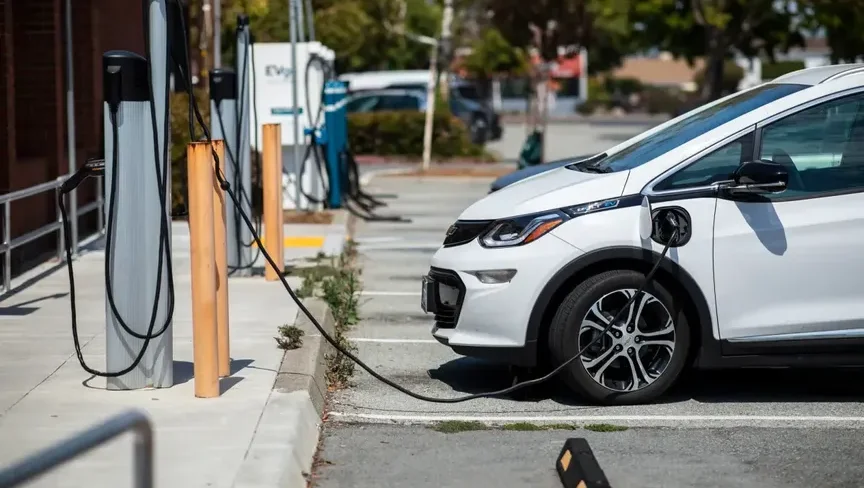
This story was first published by CalMatters.
California’s push to electrify its cars is facing a potentially serious problem: People aren’t buying electric cars fast enough.
After three straight years of strong growth, sales have stabilized in California, raising questions about whether the state will fail to meet its groundbreaking mandate banning sales of gas-powered vehicles.
About a quarter — 25.3% — of all new cars registered in California in 2024 were zero emissions, just slightly more than 25% in 2023, according to new California Energy Commission data. The flat sales follow several years of rapid growth; in 2020, only one in 13 cars sold was zero-emissions. Their share of California’s market is now three times larger than four years ago.
But the slowed pace of growth in the market puts the state’s climate and air pollution goals at risk. Under California’s mandate, approved in 2022, 35% of new 2026 car models sold by automakers must be zero-emissions. That leaves considerable ground to make up as some 2026 models begin rolling out later this year.
The requirement ramps up to 68% for 2030 models, and in 2035, California’s rule bans all sales of gasoline-powered cars.

David Simpson, who owns three car dealerships in Orange County, said he is not seeing increased demand for electric cars. While the initial rollout of some models, such as the GMC Hummer EV, did well at first, the demand did not continue. Sales of the Chevrolet Equinox and Blazer EVs do alright but aren’t strong, either, he said.
“The sales are declining,” Simpson said. “We’ve filled that gap of people who want those cars — and now they have them — and we’re not seeing a big, huge demand. I don’t see households going 100% EV.”
Dave Clegern, a spokesperson for the California Air Resources Board, which oversees the electric car mandates, said in an email that while sales of zero-emission vehicles in California are “less dramatic than in years past,” the flat sales occurred in the context of an overall plateauing of car sales last year.
Although the rules limit what automakers can sell, Californians are not required to buy electric cars. That means if consumer demand doesn’t increase, it could be a major black eye for Gov. Gavin Newsom, who has made electric cars a cornerstone of his agenda to fight climate change and clean the air. A spokesman for Newsom declined to comment.
The state mandate, however, has some flexibility, Clegern said. First of all, it’s a multi-year formula: Each manufacturer’s sales of 2026 zero-emission vehicles must be 35% of its total sales averaged for model years 2022 through 2024.
Manufacturers also can buy credits from automakers that have exceeded the target — companies that only sell electric models, such as Tesla or Rivian. To enforce compliance with California’s sales requirements, state officials could impose steep penalties of $20,000 per vehicle on manufacturers that fall short of quotas.
“Manufacturers may still be in compliance even if they do not achieve these specific sales volumes,” Clegern said.
Brian Maas, president of the California New Car Dealers Association, said automakers could seek to avoid the fines by reducing the number of gas-powered cars they send to California dealers. He said that could leave fewer options for buyers, drive up prices, and push some consumers to Nevada or Arizona to find the car they want, while others will hold on to their older, more polluting vehicles.
“We’re just not going to make the mandate as presently drafted,” so automakers will have to take action, Maas said. “The most rational is to constrain inventory.”
The auto industry group Alliance for Automotive Innovation has been raising these concerns since at least December, when it published a memo entitled “It’s gonna take a miracle: California and states with EV sales requirements.” The group warns the mandate could depress auto sales in California — as well as in other states that adopt its rules.
Last month, John Bozzella, the group’s chief executive, called California’s rules “by any measure not achievable” after President Donald Trump signed an executive order repealing federal rules promoting electric vehicles.
“There’s a saying in the auto business: You can’t get ahead of the customer,” Bozzella said.
The outgoing Biden administration’s U.S. Environmental Protection Agency granted California a waiver in December that allows the state to enforce its requirements phasing out new gas-powered cars. Many experts believe the Trump administration is likely to challenge the waiver through the courts.
Experts also anticipate that Trump could eliminate the $7,500 federal tax credit for zero-emission vehicle purchases, which would increase the cost of buying some electric cars. Newsom vowed last year to continue offering the incentive through state funding, although that promise came before Los Angeles faced devastating wildfires and the state released its fragile budget earlier this year.
Californians have purchased more than 2 million electric cars, leading the nation. The number has doubled in about two years.
But electric vehicle sales, which make up the majority of zero-emission cars, grew by only 1.1% in 2024, with 378,910 sold compared to 374,668 in 2023. Plug-in hybrids, once considered a potential alternative to a purely electric model, remained relatively stable. And sales of hydrogen-powered cars all but collapsed last year, with sales plummeting to a meager 600 in 2024 from 3,119 in 2023.
The slower growth comes amid overall market sluggishness, with all auto sales in California dipping slightly last year to 1,752,030.
Loren McDonald, chief analyst for the charging app Paren, said a major contributor is a shift in consumer demographics.
The state’s market has moved beyond early electric car adopters — affluent, environmentally motivated buyers willing to overlook challenges like limited charging infrastructure and higher costs — and into the mainstream.
He said these new buyers, often from middle-income households or who live in apartment buildings without easy access to charging, are far less forgiving when it comes to electric cars. Concerns about range, broken chargers, and upfront costs are deal-breakers.
Tesla’s market dominance has exacerbated the issue. Many left-leaning California consumers, who were once loyal to Tesla, appear to have distanced themselves because of CEO Elon Musk’s controversial public persona and alliance with Trump.
As Tesla sales have softened, dropping 11% in California last year, the decline has disproportionately affected overall EV registration data in California because of the company’s significant market share, McDonald said.
Affordability remains a crucial hurdle, though McDonald sees signs of improvement. Automakers have ramped up production, leading to competitive pricing and aggressive lease deals — many under $400 per month.
But mainstream consumers are largely unaware that electric vehicles offer long-term savings in fuel and maintenance, McDonald said, adding that better education is needed to convince consumers to take the leap, especially as electric car prices increasingly approach parity with gas-powered vehicles.
McDonald remains optimistic about 2025. The market will benefit from new electric models priced under $50,000 and technological advancements, such as faster charging and vehicle-to-home power capabilities.
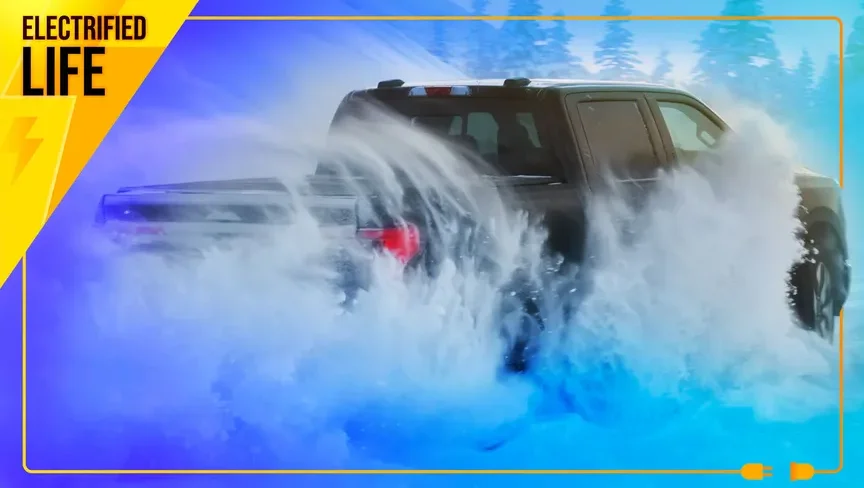
Canary Media’s Electrified Life column shares real-world tales, tips, and insights to demystify what individuals can do to shift their homes and lives to clean electric power.
Andrew Garberson isn’t worried about his electric vehicle handling cold winters.
He recently drove his EV to the gym when the temperature where he lives in Des Moines, Iowa, was a biting 4 degrees Fahrenheit. A polar vortex had brought a brutal wind, “the kind that whistles in the cracks of the car doors when you drive.”
Garberson relies on his electric truck, a graphite-gray Rivian, for year-round family road trips to see his parents, who live a few hours away. “My car will drive 200 miles in freezing conditions in the Midwest,” said the head of growth and research at Recurrent, a company that aggregates data on battery health from more than 29,000 EVs across the United States.
Switching from a gas car to an EV is one the biggest actions an individual can take to reduce their emissions. But EVs have gotten something of a bad rep in cold weather. It’s true that they, like gas cars, lose range as temperatures fall: Depending on the EV, the drop can be 16% to 46%. That loss may be anxiety-provoking, especially for EV owners-to-be.
From Garberson’s perspective, the criticisms are overblown. EVs work even in the most bone-chilling climates across the continental U.S., he said. In any case, Recurrent has found that knowledge and experience go a long way toward relieving those fears.
Plenty of frosty regions are embracing electric cars. Just look at Chicago. Despite its freezing winters, it’s one of the top cities for EV registrations, with more than 25,000 in the 12 months ending in June 2024, according to Experian’s most recent available data. Outside the U.S., the trend holds, too: In Norway, where temperatures can drop below -4˚F, nearly 9 out of 10 new cars sold in 2024 were fully electric.
In this article, we’ll dive into how to get the most winter range out of an EV. First up is a key EV feature to look for if you’re still shopping. Then, for those who already have an electric car, Garberson shares his top range-extending strategies.
EV range shrinks in the cold partly because the chemical reaction in their massive lithium-ion batteries slows down. But the biggest reason for winter range decline is the need to keep passengers warm, Garberson said.
Gas cars use the waste heat generated from the internal combustion engine for cabin heating. EVs don’t have an engine (they have a motor), so they don’t produce enough accidental heat to keep occupants cozy in frigid weather. Instead, EVs siphon energy from the battery to heat the cab, leaving less for propulsion. EVs can either make heat with an electric-resistance heater, which is like turning on a toaster, or much more efficiently move heat from the outdoors into the car using a heat pump.
Heat pumps are famous for their critical role in decarbonizing space heating in buildings. They don’t burn fossil fuel, and they’re typically two to three times as efficient as gas and electric-resistance systems, even below freezing. But the tech has also made its way into clothes dryers and water heaters. Now found in some EVs, heat pumps improve range by 8% to 10% in cold conditions, according to Recurrent.

According to Recurrent’s analysis, electric vehicles with the best winter range tend to have heat pumps, including the Tesla Models X, S, 3, and Y; Audi e-tron; and Hyundai Ioniq 5 and Kona.

It’s worth pointing out that heat pumps themselves are less effective as temperatures drop. Even so, EVs with heat pumps offer better range than those with electric-resistance heating. Recurrent points out that at 55˚F, a heat pump reduced range by 20% while a resistance heater lowered it by 33%. As the weather gets colder, the difference in range between EVs with heat pumps and those with resistance heaters shrinks.
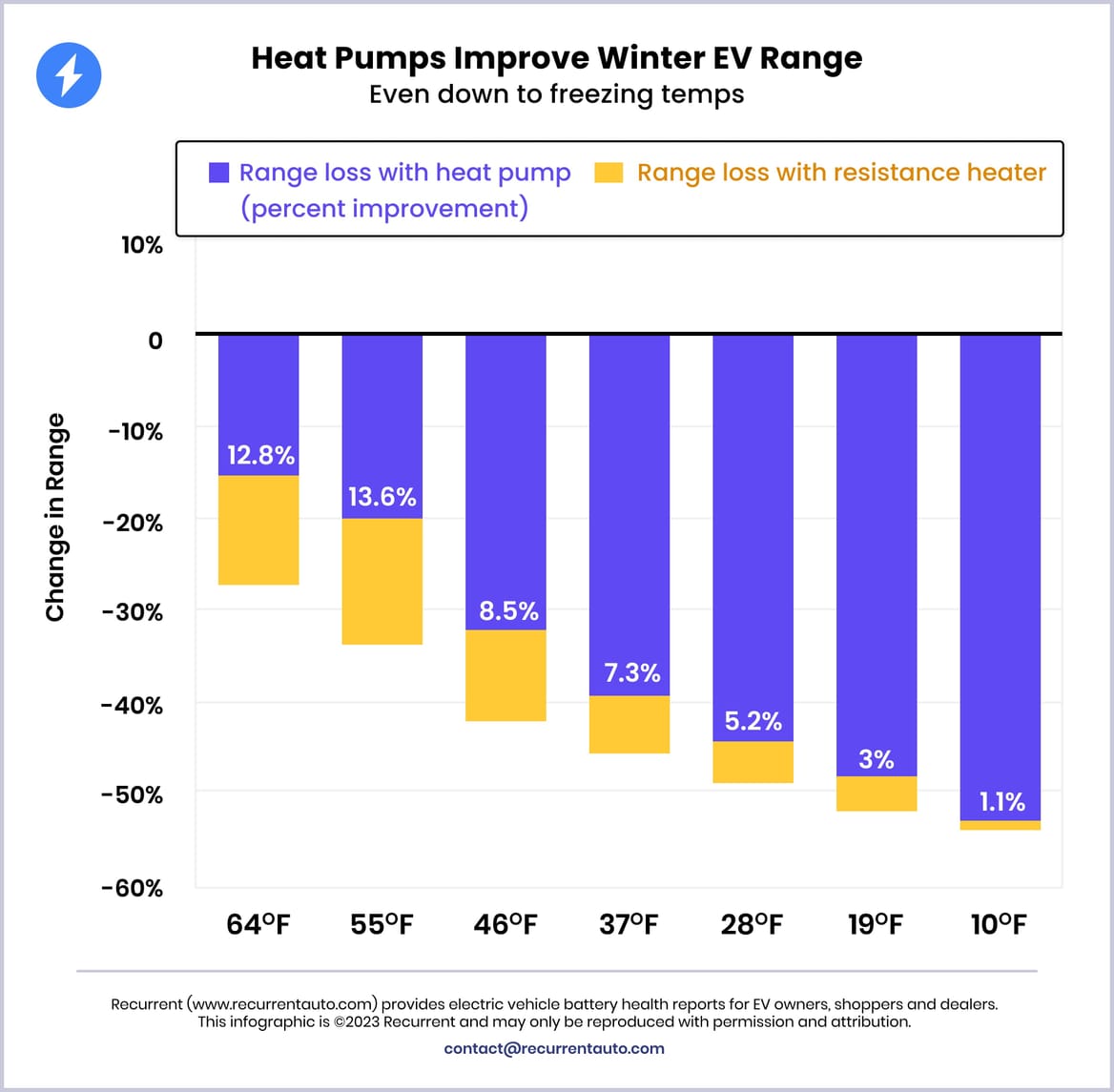
To be clear, EVs work well in the winter even without heat pumps, Garberson said. His Rivian truck doesn’t have one, and on a day-to-day basis, he doesn’t even notice the decline in range. He charges at home, which makes topping up easy. For longer road trips, cold weather might mean he needs one more charging stop than he normally would.
Heating technology aside, drivers can take steps to get more out of their EVs in the cold. Recurrent’s Garberson offered his top three range-saving strategies for winter EV drivers.
Prewarm your EV while it’s plugged in. Garberson’s garage isn’t climate-controlled, so his vehicle gets chilly when the weather does. About 10 minutes before he hops in, he uses his car’s app to warm up the cabin. Pulling electricity from the wall outlet means he won’t have to use the battery to bring his car from 4˚F to a toasty 70°F.
Set your charging limit higher. Batteries are happiest when balanced at 50% charge, Garberson said. Because huge charge-level swings are harder on the battery, Recurrent recommends keeping it between 20% and 80% full. But “let’s eliminate anxiety from the discussion and just charge cars a bit more in cold conditions,” he advised. If you normally charge to 70% to keep the battery healthy, as Garberson does, increase it to 80% in the winter.
When you’re headed to a fast charger, set the destination in the car’s GPS, a feature in most modern EVs. Letting the EV know will allow it to start preconditioning the battery so it’s ready to charge when you get there. Otherwise, you may need to wait 15 to 20 minutes at the charger for the battery to warm up sufficiently, Garberson said. “It’s just amazing how [electric] vehicles have been designed over the last few years to help drivers without them even knowing.”
One more tip for your kit? Turning on the heated steering wheel and heated seats “is a far more efficient way” to warm yourself and passengers than heating up the air in the car’s cabin, Garberson said. Once the car is prewarmed and you’re on the road, you could dial down the thermostat and use the targeted heat features to keep you cozy.
But most importantly, Garberson added, do what you need in order to keep yourself and your passengers happy. He’s father to a one-year-old, so “relying on heated seats is not part of my driving equation.”
Besides, “I will admit I am kind of a sucker for creature comforts,” Garberson said. “I need heat any way I can get it.”
Manufacturers provide even more advice on how to extend the winter range of your particular EV model, so be sure to check out their online guides.
A little planning and know-how can go a long way toward a smooth EV experience in frosty weather, Garberson said. Winter takes a bite out of his EV’s range, yes, but “I get by just fine.”
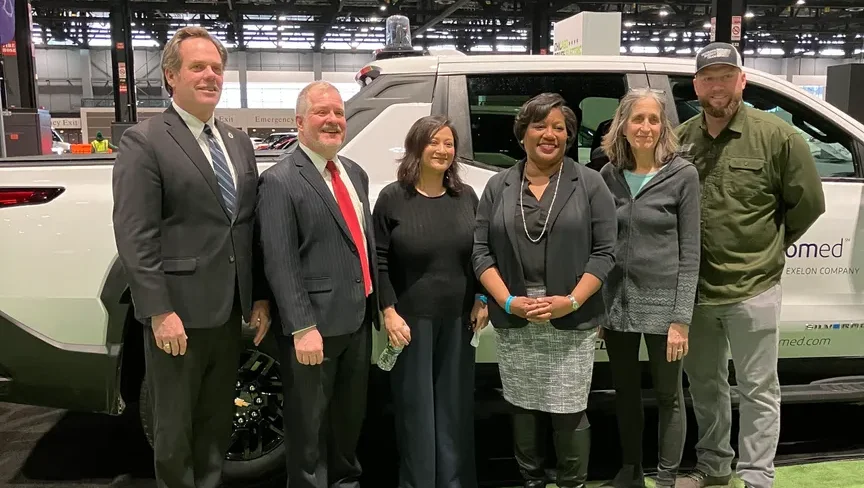
As the Trump administration attempts to block billions of dollars in federal funds for electric vehicle charging, an Illinois utility is moving forward with a massive investment to promote wider EV adoption.
At a press conference last Thursday ahead of the 2025 Chicago Auto Show, ComEd announced $100 million in new rebates designed to boost EV fleet purchases and charging stations across northern Illinois. The program helps meet the mandate for the state’s Climate and Equitable Jobs Act, which calls for 1 million EVs on the roads by 2030.
Of the $100 million, $53 million is available for business and public-sector EV fleet purchases, while nearly $38 million is designated to upgrade infrastructure for non-residential charger installations. An additional nearly $9 million is intended for residential charging stations.
The money is in addition to $87 million announced last year for similar incentives.
Funding for the rebate programs comes from distribution charges and “has nothing to do” with the federal government, Melissa Washington, senior vice president of customer operations and strategic initiatives at ComEd, said during an interview. This means that there is no risk of withholding or reductions from the Trump administration.
Washington anticipates continued high levels of interest and engagement in the programs.
“Based upon what we saw last year, there was a quick demand. Applications came right away the minute we opened it up. I would imagine people will be going on [ComEd’s website] and immediately trying to see what we have available for them,” Washington said.
Since launching its EV rebate program last year, ComEd has funded projects in more than 300 ZIP codes, including nearly 3,500 residential and commercial charging ports, and provided funding for municipalities, businesses, and school districts to purchase more than 200 new and pre-owned EV fleet vehicles. The utility designated more than half the available rebate funds for low-income customers and projects in environmental justice communities.
ComEd also partners with the Chicago-area Metropolitan Mayors Caucus on the EV Readiness Program, which helps local governments create ordinances and safety and infrastructure plans to accommodate the growing demand for EVs in their communities. Since its initiation, more than 41 northern Illinois municipalities have participated in the program.
The importance of utility funding for the rebate programs was highlighted by Susan Mudd, senior policy advocate for the Environmental Law and Policy Center, who noted that a St. Louis-area school district is still waiting on 21 electric school buses that had been promised and ordered. The district has been unable to access the online portal to receive its federal funding, due to an executive order issued by the Trump administration.
“During the last four years, the federal government was a reliable partner with policies and programs that helped propel electric vehicle production and implementation and updated standards to save consumers money while cleaning up the air,” Mudd said at the press conference. “That order has already meant that students who would already be riding quiet zero-emission buses are still on old, dirty diesel ones, and the business that was to deliver them can’t get paid.
“While the new administration is willing to sacrifice the health of people across the U.S. and the world, thankfully, we in Illinois can continue to improve things,” Mudd said.
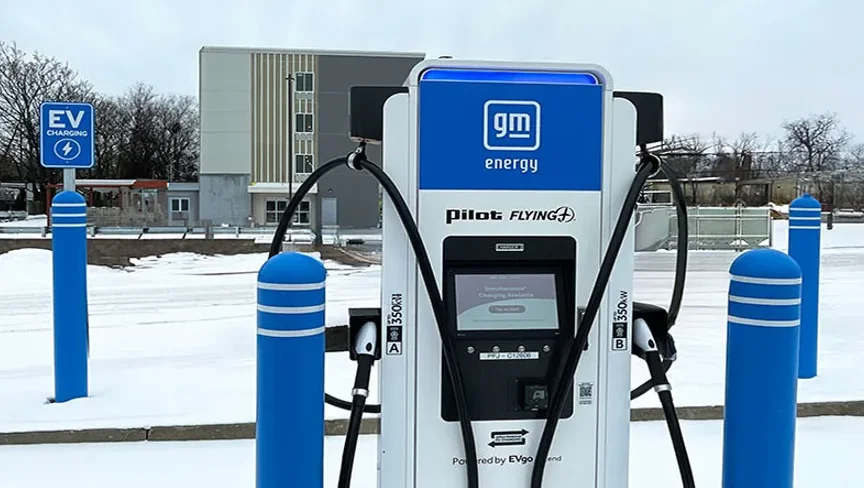
The Trump administration has declared that it is rescinding guidance for a $5 billion program that funds EV-charging installations nationwide, potentially halting states’ plans to put billions of obligated but as-yet unspent dollars to work. It’s the new administration’s latest attack on federal climate and clean energy programs authorized by Congress during the Biden administration, and like the others, it’s almost certain to be challenged in court, experts say.
The unexpected news came in a Thursday memo from the Federal Highway Administration to state transportation departments responsible for managing the National Electric Vehicle Infrastructure Formula Program. NEVI was created by the bipartisan infrastructure law passed by Congress in 2021 to establish reliable charging along major highways across the country. The program is structured to guarantee states access to funds under federally approved plans through fiscal year 2026.
The memo states that FHWA is “immediately suspending the approval” of these state plans pending a U.S. Department of Transportation review. States’ “reimbursement of existing obligations will be allowed in order to not disrupt current financial commitments,” the memo notes. But “no new obligations may occur” until new guidance is developed and states submit and receive approval for their updated plans — a process that could last through the rest of this year.
The memo’s instructions conflict with longstanding practice of guaranteeing states access to federal highway spending as well as with the structure of the NEVI program set by Congress in the infrastructure law.
“Freezing these EV charging funds is yet another one of the Trump administration’s unsound and illegal moves,” Katherine García, Sierra Club’s clean transportation for all director, said in a Friday statement. “This is an attack on bipartisan funding that Congress approved years ago and is driving investment and innovation in every state, with Texas as the largest beneficiary.” The Lone Star State is slated to receive nearly $408 million from the program.
Of the $5 billion authorized by NEVI, $3.27 billion has been obligated to all 50 states, Washington, D.C., and Puerto Rico, according to EV-charging data firm Paren. Of that, roughly $615 million is under contract for constructing almost 1,000 charging sites, Loren McDonald, Paren’s chief analyst, said in a webinar last month.
In a Thursday email, McDonald highlighted that “companies that are under contract with a state and have incurred expenses will get reimbursed.” At the same time, “the experts in Washington, D.C., that we have spoken to in the last few months believe that changes in NEVI like this would require a change in the law from Congress.”
“Our understanding is that FHWA does not have the authority to actually halt or revise the NEVI program this extensively, but will move forward, creating havoc for several months until lawsuits, the courts, and Congress resolve it,” he wrote.
Under the Biden administration, NEVI program formula funding was allocated through fiscal year 2026, and FHWA had approved states’ annual spending plans through fiscal year 2025, Kelsey Blongewicz, policy analyst at research firm Atlas Public Policy, told Canary Media last month.
That funding is “tied to approved state plans and contracts that makes it nearly impossible to reverse or stop,” Beth Hammon, senior EV infrastructure advocate at the Natural Resources Defense Council, wrote in a blog post last month.
Still, FHWA’s new instructions “create great uncertainty for the billions of dollars states and private companies are investing in the urgently needed infrastructure to support America’s highway transportation network,” Ryan Gallentine, managing director at Advanced Energy United, said in a Thursday statement. The trade group represents EV manufacturers, charging infrastructure developers, and other companies involved in NEVI-funded projects.
“States are under no obligation to stop these projects based solely on this announcement,” he wrote. “We call on state DOTs and program administrators to continue executing this program until new guidance is finalized.”
President Donald Trump attacked EVs and the NEVI program on the campaign trail. His administration issued an executive order within hours of his inauguration demanding a halt to all Biden-era climate and clean energy spending and singled out the NEVI program for scrutiny.
Federal agencies have since halted the flow of tens of billions of dollars of federal climate and clean energy funding, drawing outrage from state agencies, nonprofit groups, and companies that have been unable to recover money already spent on projects and programs. Two federal judges have responded to lawsuits challenging the freeze by issuing court orders demanding a halt to them, but a multitude of programs remain inaccessible, according to reports from grant recipients.
Confusion over the NEVI program’s future comes at a moment when significant investments are starting to flow from states to EV-charging manufacturers and charging-network providers — including Tesla — after years of bureaucratic and administrative delays. Federal data as of November tracked 126 operational public charging ports at 31 sites built using NEVI funding.
The Biden administration hoped to spur the buildout of 500,000 public charging stations by 2030, up from about 206,000 today. The NEVI program wasn’t intended to build all those chargers itself but to help install them in places where the economics of providing EV charging aren’t yet supported by the number of EVs on the road, McDonald said.
“In many states, the NEVI program helped jumpstart investment in high-speed EV charging stations, getting high-speed chargers at the gas stations and truck stops where millions of drivers already stop every year,” Ryan McKinnon, spokesperson for Charge Ahead Partnership, a trade group representing fueling-station owners and convenience store chains that make up the majority of NEVI charging sites, said in a Friday statement. “Other states dragged their feet.”
According to McDonald, since NEVI was singled out by the Trump administration, six states have indefinitely discontinued work on it, including Ohio, the Republican-led state that installed the program’s first live chargers in 2023.
UPDATE: In a Friday email, an FHWA spokesperson stated the agency is “utilizing the unique authority afforded under the NEVI Formula Program to ensure the Program operates efficiently and effectively and aligns with current U.S. DOT policies and priorities.”

Massachusetts’ attorney general says plans by the state’s major utilities to lower the cost of charging electric vehicles would offer little actual savings for customers.
In response to a 2022 Massachusetts climate law, the state’s two primary electric utilities, Eversource and National Grid, have proposed plans to create lower rates for charging EVs during off-peak hours, which they say would be implemented no sooner than 2029.
In a regulatory filing last week, however, the state’s attorney general said the utilities’ estimated savings for customers are based on faulty calculations and would be much lower in reality. Plus, a requirement that households and small businesses pay for additional meters to track their charging stations’ power use “negates all financial value for the customer.”
With this filing, the attorney general’s office joins climate advocates who support the idea of offering EV drivers the chance to save money by charging during off-peak hours but take issue with the way utilities propose to implement the strategy.
“If you require that people install a second meter and that they cover the cost of that installation, nobody’s going to do it,” said Anna Vanderspek, electric vehicle program director at the Green Energy Consumers Alliance.
Regulators have asked the utilities for feedback on the attorney general’s concerns and recommendations by February 20. A spokesperson for Eversource did not specifically address the attorney general’s criticism when asked about it but said the utility believes in the benefits of time-of-use pricing and looks forward to continuing the regulatory process. National Grid did not respond to a request for comment in time for publication.
More than a third of cars sold in the United States are likely to be EVs by 2030, J.D. Power forecasts, a prospect that has many industry and elected leaders wondering whether the country’s electric infrastructure is ready to provide power for this growing, gas-free fleet.
Massachusetts has set the ambitious target of putting 900,000 EVs on the road — and on the grid — by 2030. So, like other states facing the same challenges, Massachusetts has turned to the idea of using financial incentives to encourage EV owners to charge during off-peak hours and to lower the cost of charging for drivers in a state where electricity prices are among the highest in the country.
“Electric vehicle time-of-use rates could be a very valuable tool for helping to alleviate the load on the system as well as helping to incentivize people to think about when they’re using electricity,” said Priya Gandbhir, director of clean power at the Conservation Law Foundation.
In the 2022 climate law, legislators required utilities to propose these so-called time-of-use rates, which both Eversource and National Grid did in August 2023.
Eversource’s plan calls for a $15 monthly fee and an off-peak EV charging rate of 19 cents per kilowatt-hour, slightly more than half the proposed peak rate. National Grid would impose a $10 monthly fee and charge 14 cents per kilowatt-hour for off-peak charging, half what the peak rate would be. Both plans would require a separate meter, and both contend the rates cannot be implemented before advanced metering infrastructure is rolled out and tested, a process they expect to take at least four years.
Regulators must rule on these proposals by the end of October.
The numbers laid out by the utilities don’t add up to savings for consumers, the attorney general’s testimony argues. Thus, the proposals are unlikely to motivate more people to buy EVs or to shift their charging times.
The utilities did not estimate the cost of installing a separate meter, but online estimates run from $1,400 to more than $4,000. At the same time, the utilities drastically overstated the savings their plans would yield by using inflated estimates for how many kilowatt-hours the average driver would use to charge their EV, the attorney general’s testimony says. Rather than saving as much as $146 a month, as the utilities calculated, drivers would cut their bill by $21 per month at most, assuming they do all of their charging during off-peak hours. Customers who sometimes charge during peak hours could even see bill increases.
“The math just doesn’t work out,” Vanderspek said.
The attorney general’s office recommends that public utilities regulators reject National Grid and Eversource’s proposals and offers several alternative approaches. The simplest, the testimony says, would be to offer whole-home time-of-use rates, rather than separating out the vehicle charging load. Evidence from other states suggests such a rate could be implemented during the roll-out of advanced metering infrastructure, rather than waiting the minimum of four years the utilities say would be necessary for an EV-specific rate. The filing points to Colorado, where time-of-use rates are rolling out in concert with advanced metering infrastructure.
Another option would be to use data collected by vehicle computer systems or chargers themselves to issue rebates or apply lower rates for charging done at off-peak times. Utilities in California and Minnesota have already deployed this approach.
The same data could be used to offer other financial incentives. National Grid, in fact, already offers such a program in Massachusetts, giving customers 5 cents per kilowatt-hour for off-peak EV charging during the summer and 3 cents per kilowatt-hour the rest of the year.
Any of these approaches could be used not just to improve financial incentives for customers but also to speed up their implementation, to the benefit of both consumers and the environment, Vanderspek said.
“We’re all better off if we’re shifting that load off-peak right now,” she said.
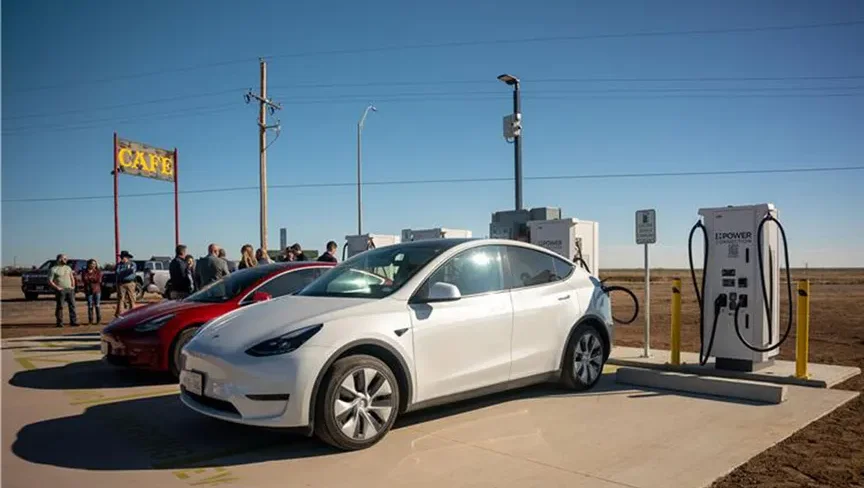
ELECTRIC VEHICLES: The Trump administration singled out funding for electric vehicle chargers in his orders halting climate and clean energy spending, but experts say agencies legally can’t hold back these “mandatory” grants allocated by Congress. (Canary Media)
POLITICS:
SOLAR:
OIL & GAS: The Trump administration directs the Army Corps of Engineers to use emergency powers to sidestep the Clean Water Act to build gas pipelines, but environmentalists say they don’t have that authority. (E&E News)
GRID:
HYDROGEN: A last-minute infusion of funds from the Biden administration will allow the Mid-Atlantic Hydrogen Hub to begin planning and collecting community input, though some environmental advocates are skeptical the process will truly be climate-friendly. (Delaware Public Media)NUCLEAR: South Carolina Gov. Henry McMaster calls for the expansion of the VC Summer nuclear plant, which previously collapsed in the “Nukegate” controversy but recently has been revived by state-owned utility Santee Cooper. (Post and Courier, South Carolina Daily Gazette)

ELECTRIC VEHICLES: Auto industry experts say rapidly falling battery prices and improving technology will prevent the incoming Trump administration and Republican Congress from stopping the country’s transition to electric vehicles. (New York Times)
ALSO:
CLIMATE:
OFFSHORE WIND:
NATURAL GAS: A group that claimed a Maryland climate bill would be harmful to Black residents had backing from a group with ties to the fossil fuel industry, which a spokesman defends as “something that happens every day in advocacy.” (Washington Post)
GRID:
COMMENTARY: A climate scientist writes that in order to solve the climate crisis, humanity needs to confront “billionairism,” the system that extracts wealth from the poor to the rich and perpetuates racism, patriarchy, and suffering. (The Guardian)
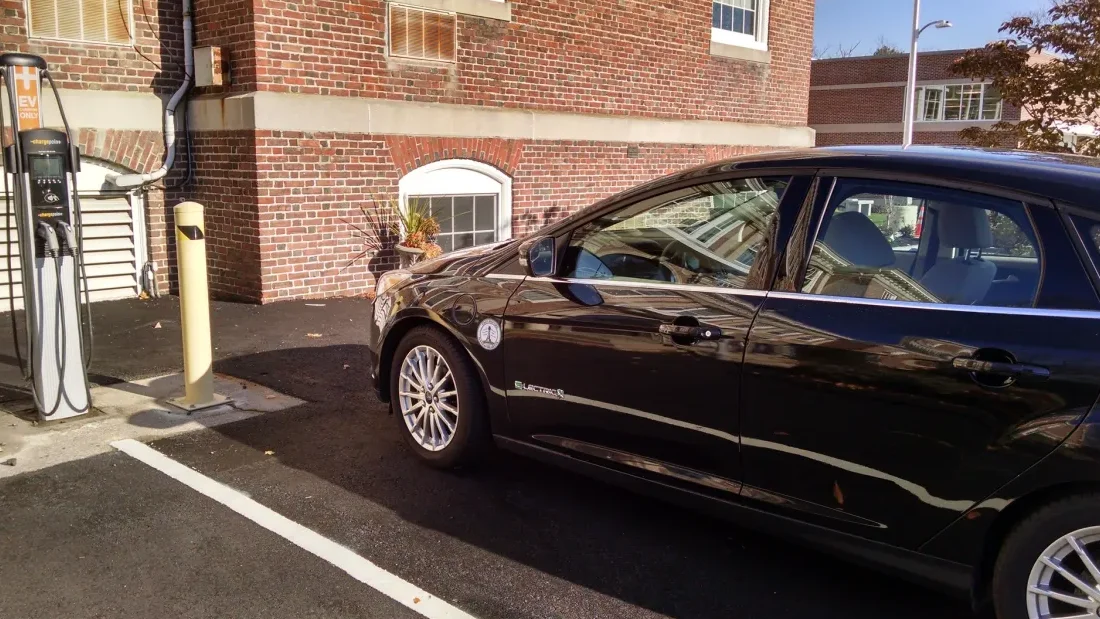
ELECTRIC VEHICLES: The inclusion of heat pumps in newer electric vehicle models is among the improvements helping to boost battery performance during cold weather, as experts say winter charging concerns have been overblown. (Inside Climate News)
ALSO: Major proposed battery plants across Michigan have been scaled back or face local opposition as automakers scale back production targets. (Crain’s Detroit, subscription)
EFFICIENCY:
PIPELINES: A carbon pipeline developer asks a South Dakota regulator to recuse herself from the company’s permit application because of an alleged conflict of interest, though the regulator says there is no legal conflict. (South Dakota Searchlight)
GRID: MISO’s recently approved transmission buildout calls for six projects in Wisconsin totaling $4.1 billion in new investment. (Wisconsin Public Radio)
NUCLEAR: 2025 could be a pivotal year for a shuttered southwestern Michigan nuclear plant as federal regulators plan to issue a final decision on its restart by the end of July. (Michigan Public)
SOLAR: Northern Michigan GOP lawmakers call for the firing of state officials involved with a natural resources agency’s plan to clear cut and lease 420 acres of forest land for a solar project. (Detroit News)
FOSSIL FUELS: Experts speculate that spiking energy demand from artificial intelligence and data centers could deliver the Trump administration a political victory by boosting the consumption of fossil fuels. (E&E News)
BIOMASS: A Minnesota nonprofit says it has devised a way of burning wood and biomass that produces biochar and prevents carbon emissions from being released during the process. (Pioneer Press)
COAL:
UTILITIES: MidAmerican Energy asks South Dakota regulators to recover more than $500,000 in costs stemming from a 2024 flooding event that damaged gas infrastructure. (KTIV)